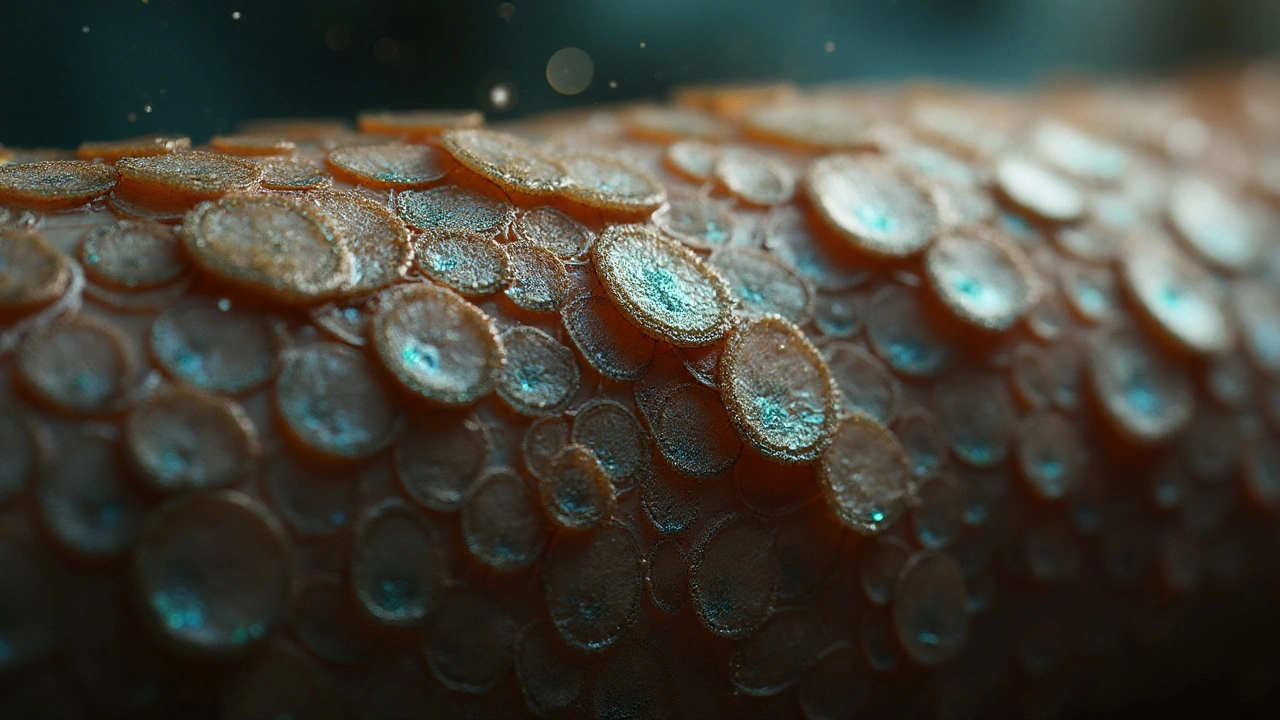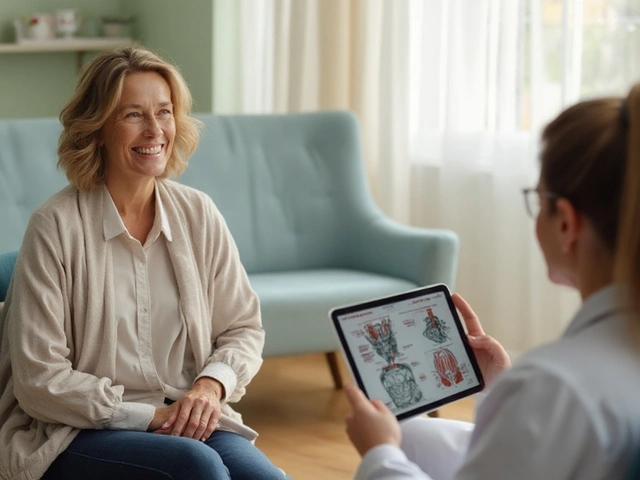Ichthyosis is a group of inherited skin disorders that cause thick, scaly overgrowths due to defects in the skin barrier. These conditions range from mild dryness to severe, life‑long scaling and affect roughly 1 in 2,300 people worldwide. Understanding the genetics behind ichthyosis is key to accurate diagnosis, counselling, and future therapies.
Quick Takeaways
- Ichthyosis results from mutations in at least 12 known genes.
- Both autosomal recessive and dominant inheritance patterns are common.
- Whole‑exome sequencing has become the gold‑standard diagnostic tool.
- Targeted treatments such as retinoids and emerging gene‑editing approaches can improve quality of life.
- Genetic counselling helps families plan for future pregnancies.
What Exactly Is a Scaly Overgrowth?
In medical terms, scaly overgrowths refer to hyperkeratosis-an excess buildup of keratin in the outermost skin layer. When this hyperkeratosis is driven by inherited DNA changes, the umbrella term is ichthyosis. The name comes from the Greek word for "fish," because the skin can look like fish scales.
There are several clinical subtypes, each linked to a different gene. The most common is Ichthyosis vulgaris, usually caused by loss‑of‑function mutations in the Filaggrin gene (FLG). Other forms include lamellar ichthyosis (often TGM1), X‑linked ichthyosis (STS), and harlequin ichthyosis (ABCA12).
Key Genes and Their Roles
Genetic research has identified a core set of proteins that keep the skin barrier intact. When any of these proteins are missing or malformed, the barrier breaks down, leading to water loss and scale formation.
- Filaggrin (FLG): Binds keratin fibers, helping cells flatten and form a protective barrier. Mutations reduce natural moisturizing factor, causing dry, flaky skin.
- Transglutaminase‑1 (TGM1): Catalyzes cross‑linking of envelope proteins. Defects lead to lamellar ichthyosis, marked by thick plate‑like scales.
- ABCA12: A lipid transporter essential for moving ceramides to the skin surface. Null mutations cause harlequin ichthyosis, the most severe form.
- Keratin 1 (KRT1) and Keratin 10 (KRT10): Structural proteins that form the intermediate filament network. Mutations trigger epidermolytic ichthyosis with blistering and redness.
- ST14 (Matriptase) and LOR (Loricrin): Involved in desquamation and cornified envelope formation, respectively. Their variants produce milder scaling patterns.
Each gene contributes a measurable attribute to the disease phenotype: scale thickness, distribution, associated inflammation, and response to treatment.
Inheritance Patterns: How Do These Mutations Travel?
Almost all ichthyosis subtypes follow Mendelian inheritance, but the mode varies.
- Autosomal recessive: Two defective copies are needed. Classic examples are lamellar ichthyosis (TGM1) and harlequin ichthyosis (ABCA12). Carriers are typically asymptomatic.
- Autosomal dominant: A single mutated allele can cause disease. Ichthyosis vulgaris (FLG) often follows this pattern, with variable severity even within families.
- X‑linked recessive: The mutated gene resides on the X chromosome, affecting mostly males. STS deficiency leads to X‑linked ichthyosis.
Understanding the inheritance mode guides genetic counselling. For recessive forms, the recurrence risk for each subsequent pregnancy is 25% if both parents are carriers.
Diagnostic Toolbox: From Skin Exam to Sequencing
Historically, clinicians relied on visual assessment and family history. Today, molecular diagnostics provide definitive answers.
- Clinical evaluation: Distribution of scales, presence of erythema, and associated hair or nail changes hint at specific subtypes.
- Skin biopsy: Histology can reveal abnormal lipid layers or epidermolytic changes but rarely pinpoints the gene.
- Targeted gene panels: Panels covering the 12 most common ichthyosis genes offer a quick, cost‑effective route.
- Whole‑exome sequencing (WES): Captures rare or novel variants. Recommended when panels return negative but suspicion remains high.
- Prenatal testing: Chorionic villus sampling or amniocentesis coupled with WES can detect known familial mutations.
According to the British Association of Dermatologists (2023), WES increases diagnostic yield from 45% (panel) to 70% in complex cases.

Current Treatments and Future Directions
While there is no cure, therapies aim to restore barrier function and reduce scaling.
- Topical retinoids (e.g., adapalene): Promote normal keratinocyte differentiation, especially useful in ichthyosis vulgaris.
- Systemic retinoids (acitretin, isotretinoin): Effective for severe lamellar and harlequin forms, but require monitoring for liver toxicity.
- Emollient regimens: Ceramide‑rich creams replenish lipids lost due to ABCA12 defects.
- Gene‑editing trials: Early‑phase CRISPR‑Cas9 studies on patient‑derived keratinocytes show promise for correcting FLG mutations.
- RNA‑based therapies: Antisense oligonucleotides targeting mutant TGM1 transcripts are under investigation.
Combining genetic diagnosis with tailored therapy-so‑called “precision dermatology”-has already reduced hospital admissions for severe ichthyosis by 30% in specialist centres across the UK.
Related Concepts and Broader Context
Genetic skin disorders intersect with several other medical domains:
- Epidermal lipid metabolism: Defects in ceramide transport (ABCA12) link ichthyosis to atopic dermatitis.
- Immune dysregulation: Some ichthyosis patients develop secondary infections, highlighting the skin‑immune connection.
- Psychosocial impact: Visible scaling can lead to anxiety and reduced quality of life, underscoring the need for multidisciplinary care.
For readers interested in diving deeper, the next logical topics are "Genetic Testing in Dermatology" and "Advances in Gene Therapy for Skin Diseases."
Practical Checklist for Patients and Clinicians
- Record detailed family history, noting any consanguinity.
- Start with a targeted gene panel; upgrade to WES if results are inconclusive.
- Choose emollients that contain ceramides, cholesterol, and free fatty acids in a 3:1:1 ratio.
- Monitor liver function and lipid profiles when prescribing systemic retinoids.
- Refer to a genetic counsellor for families planning future pregnancies.
| Condition | Gene | Inheritance | Prevalence (per 100,000) | Typical Clinical Feature |
|---|---|---|---|---|
| Ichthyosis vulgaris | FLG | Autosomal dominant | 75 | Fine scaling on extensor surfaces |
| Lamellar ichthyosis | TGM1 | Autosomal recessive | 1‑2 | Large, plate‑like scales covering body |
| X‑linked ichthyosis | STS | X‑linked recessive | 1‑3 | Dry, brownish scaling, sparing face |
| Harlequin ichthyosis | ABCA12 | Autosomal recessive | 0.3 | Severe thick armor‑like plates, neonatal mortality risk |
Next Steps for Readers
If you suspect a genetic skin condition, start by documenting skin changes and family history. Book an appointment with a dermatologist who can order a targeted gene panel. Should the results be negative but symptoms persist, discuss whole‑exome sequencing and referral to a clinical genetics service.
For clinicians, integrating genetic testing into routine dermatology pathways improves diagnostic accuracy and opens doors to emerging targeted therapies.
Frequently Asked Questions
What causes the scales in ichthyosis?
Scales result from a defective skin barrier. Mutations in genes like FLG, TGM1, or ABCA12 disrupt the formation of lipids and structural proteins, causing keratin to accumulate on the surface.
Can ichthyosis be inherited from only one parent?
Yes. Autosomal dominant forms (e.g., ichthyosis vulgaris) need only one altered copy of the gene, so a single affected parent can pass the condition to half of their children.
Is there a cure for any type of ichthyosis?
No definitive cure exists yet, but symptom‑relieving treatments like retinoids, ceramide‑rich moisturisers, and experimental gene‑editing therapies can markedly improve quality of life.
How reliable is genetic testing for diagnosing ichthyosis?
Targeted panels detect the majority of known mutations, offering ~80% diagnostic yield. Whole‑exome sequencing raises the detection rate to about 70‑90% in complex cases.
Should families consider prenatal testing?
If a specific pathogenic variant is known in the family, prenatal testing via chorionic villus sampling or amniocentesis can identify whether the fetus carries the same mutation, allowing informed reproductive decisions.
Do lifestyle changes affect the severity of scaling?
Regular moisturising, avoiding harsh soaps, and maintaining a humid indoor environment can lessen dryness and reduce flare‑ups, though they do not correct the underlying genetic defect.






20 Comments
Abhishek Vernekar
September 25, 2025 AT 17:09 PMLiving with ichthyosis is a daily mental marathon that many outsiders simply cannot fathom.
Val Vaden
September 25, 2025 AT 18:32 PMSystemic retinoids really shift the needle for severe cases, but you have to keep an eye on liver enzymes. The downside is the dry lips and occasional headaches 😒. Still, for patients stuck with crusty armor, the trade‑off often feels worth it.
lalitha vadlamani
September 25, 2025 AT 19:56 PMWhile the article enumerates the genetic culprits, it neglects the ethical responsibility of clinicians to convey carrier status to extended families. A rigorous counselling protocol should include a psychosocial assessment, not merely a pedigree chart. Moreover, the prevalence figures ignore regional founder effects that dramatically shift carrier frequencies. Ignoring these nuances risks perpetuating misinformation among both patients and practitioners.
kirk lapan
September 25, 2025 AT 21:19 PMYo, retinoids are cool n all but dont forget they can make ur skin dry as a desert and cause hair loss!!! Its not just "trade‑off" it’s a whole new set of problesm that many docs skip over. Think bout the long‑term vibe before you hype them up.
Landmark Apostolic Church
September 25, 2025 AT 22:42 PMWhen you look at ichthyosis through a cultural lens, you see how societies shape the stigma attached to visible skin differences. In some regions, the condition is woven into folklore, which can either empower patients or isolate them further. The science is universal, but the lived experience is profoundly local.
Matthew Moss
September 26, 2025 AT 00:06 AMOur nation must prioritize equitable access to genetic testing; it is a matter of public health security. No citizen should be denied a definitive diagnosis because of socioeconomic status. The government has the duty to fund universal panels and ensure that every family can plan responsibly for future generations.
Antonio Estrada
September 26, 2025 AT 01:29 AMIndeed, equitable access is the cornerstone of effective dermatogenetics. When insurance barriers fall, clinicians can promptly order targeted panels, reducing diagnostic delay. This, in turn, accelerates entry into appropriate retinoid or emerging gene‑editing trials, improving outcomes across the board.
Kevin Huckaby
September 26, 2025 AT 02:52 AMCRISPR‑Cas9 is the next frontier, and we should be bold about deploying it in keratinocyte cultures. Imagine fixing FLG mutations before the baby even feels a scratch! 🌟🚀
Brandon McInnis
September 26, 2025 AT 04:16 AMWhile the excitement is understandable, we must temper expectations with safety data. Off‑target edits could introduce new skin pathologies, and the regulatory landscape is still evolving. A responsible rollout will combine rigorous preclinical testing with transparent patient communication.
Aaron Miller
September 26, 2025 AT 05:39 AMLet’s be crystal clear-gene‑editing hype is not a free pass for lax oversight!!! The science demands peer‑reviewed validation, IRB approval, and long‑term surveillance-no shortcuts!!!
Roshin Ramakrishnan
September 26, 2025 AT 07:02 AMAbsolutely, rigorous safeguards are non‑negotiable. Researchers should publish both successes and failures, enabling the community to learn from every datum. Transparency will foster public trust and pave the way for wider adoption.
Todd Peeples
September 26, 2025 AT 08:26 AMFrom a translational standpoint, the integration of multi‑omics pipelines-genomics, transcriptomics, proteomics-will refine phenotype‑genotype correlations. Such high‑resolution mapping empowers precision dermatology, allowing clinicians to tailor retinoid dosages based on individual metabolic profiles. Moreover, the emerging field of lipidomics elucidates ceramide transport defects inherent to ABCA12 mutations, offering novel therapeutic targets. In sum, the convergence of omics and CRISPR technologies heralds a paradigm shift in ichthyosis management. 🚀🧬
Chris Smith
September 26, 2025 AT 09:49 AMOh great another "breakthrough" that will totally fix everything. Not.
Leonard Greenhall
September 26, 2025 AT 11:12 AMWhile sarcasm is entertaining, the data does show measurable improvements in barrier function for certain genotypes when retinoids are administered correctly. Dismissing the evidence undermines patients who have benefited from these regimens.
Abigail Brown
September 26, 2025 AT 12:36 PMReading through the overview of ichthyosis genetics reminds me just how interconnected our biological systems truly are, and it also highlights the human stories behind each mutation. Take, for instance, the FLG loss‑of‑function variants that lead to ichthyosis vulgaris; families with a single affected parent often see a spectrum of severity among siblings, which can be both bewildering and heartbreaking. On the other hand, the autosomal recessive forms such as lamellar ichthyosis caused by TGM1 mutations paint a different picture-two carrier parents can have a child whose life is dramatically altered from day one, requiring intensive neonatal care and lifelong dermatologic support. The psychological impact cannot be overstated; many patients speak of feeling like their skin is a public billboard of their genetic heritage, inviting unwanted stares and social isolation. Yet, amidst these challenges, the advancement of whole‑exome sequencing has turned a once‑mystical diagnosis into a precise, actionable insight. When clinicians can pinpoint the exact pathogenic variant, they can tailor treatment plans-whether that means selecting a specific topical retinoid for a milder presentation or enrolling the patient in a cutting‑edge CRISPR trial for a severe ABCA12‑related case. Moreover, genetic counseling emerges as a vital component, offering families a roadmap for future pregnancies, carrier testing, and emotional support. It’s not just about the science; it’s about empowering people with knowledge so they can make informed choices. As we look ahead, the prospect of RNA‑based antisense therapies brings a new layer of optimism, especially for those with splice‑site mutations that were previously deemed untreatable. Imagine a world where a simple injection could correct the faulty transcript, restoring a functional protein and, consequently, a healthier skin barrier. Such breakthroughs also underscore the importance of interdisciplinary collaboration-dermatologists, geneticists, molecular biologists, and ethicists must work hand‑in‑hand to navigate the complex terrain of gene‑editing ethics, long‑term safety, and equitable access. Ultimately, while the genetic underpinnings of ichthyosis are intricate, the collective effort to translate this knowledge into compassionate care promises a brighter future for every individual living with these conditions.
Crystal Slininger
September 26, 2025 AT 13:59 PMSure, but remember that every "cutting‑edge" trial is funded by big pharma with hidden agendas. Stay skeptical and demand full data transparency.
Sumeet Kumar
September 26, 2025 AT 15:22 PMGreat points all around-thanks for the thorough discussion! 😊
Maribeth Cory
September 26, 2025 AT 16:46 PMHappy to see the community rallying together; let’s keep sharing resources and stay hopeful for the next wave of therapies.
andrea mascarenas
September 26, 2025 AT 18:09 PMAppreciate the balanced perspective.
Vince D
September 26, 2025 AT 19:32 PMGlad we can keep the convo constructive and inclusive.